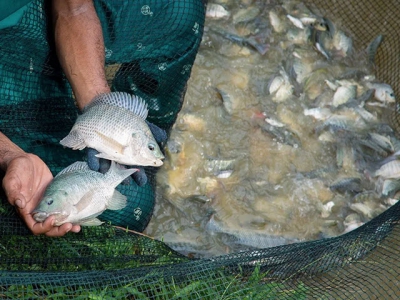New strains, new gains for Nile tilapia producers

A strain of tilapia that has been recently developed by WorldFish in Egypt is producing significantly improved fish yields, lower feed conversion ratios and improved profits for farmers.
GIANT has been developed by WorldFish as an alternative to the GIFT strain. Photo © WorldFish
The international nonprofit recently developed a new selective breeding programme in the Egyptian region of Abbassa, in a bid to improve on their well-known and widely-adopted Genetically Improved Farmed Tilapia (GIFT) strain, which was initially developed for production in Asia.
The result, known as Genetically Improved Abbassa Nile Tilapia (GIANT), was developed using the same genomic techniques and a new study on the performance of the ninth generation of the GIANT broodstock suggests it is performing exceptionally well.
The authors of the study, published under the title ‘Assessment of the impact of dissemination of genetically improved Abbassa Nile tilapia strain (GIANT‐G9) versus commercial strains in some Egyptian governorates’, in the latest issue of Aquaculture Research, looks at the impact that distributing broodstock of the strain to 11 broodstock multiplication centres (BMC’s) in five governorates. These centres then disseminated improved mixed‐sex fry to 160 tilapia hatcheries which supplied all‐male fry to 1,500 fish farms in 2017.
In their study, the WorldFish researchers present results of an impact assessment of G9 of the strain in 83 of these fish farms in four Egyptian governorates – Kafr El‐Sheikh, Fayoum, Behera and Alexandria.
Their research indicates that the use of GIANT in all governorates “achieved significantly higher (18.8%) fish yields (12.3%–26.4%) and 15.7% lower FCR (feed conversion ratio), reflecting a positive impact on their net profits compared with those who used commercial strains”.
Moreover, they note that: “Overall, fish farmers who stocked GIANT had significantly higher average fish sales (5.567 US$/ha) than those who stocked non‐improved commercial strains (5.192 US$/ha) in all governorates”.
However, they also note that farms in the four different governorates performed differently, with those in Kafr El‐Sheikh and Behera showing less of an improvement, which – they conclude –“indicates that some hatcheries may have crossed the different strains, which lowered the performance differences.”
As a result, they add: “To get an objective analysis of the performance of the GIANT, it is recommended that similar assessment be undertaken with new generations of the strain supported by on‐farm performance trials.”
Related news
 Habituation is key: how to get the most out of lumpfish
Habituation is key: how to get the most out of lumpfish A new study has shown that lumpfish who have habituated to their surroundings will consume more sea lice and exhibit less biological stress.
 Omega-3 and zinc are essential for barrier tissue health and robustness in salmon: Nofima
Omega-3 and zinc are essential for barrier tissue health and robustness in salmon: Nofima Nofima scientists' work shows that zinc and omega-3 fatty acids provide an important interaction in the intestines and likely the gills of salmon.
 Basil oil may boost tilapia growth
Basil oil may boost tilapia growth Basil essential oil may improve the growth, intestinal function and performance of farm-raised juvenile Nile tilapia, say researchers.